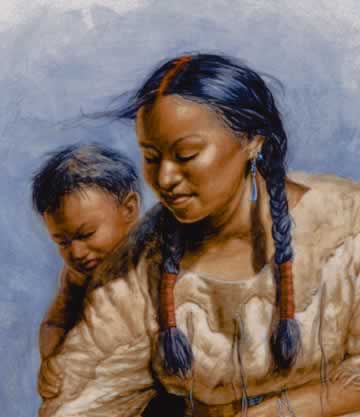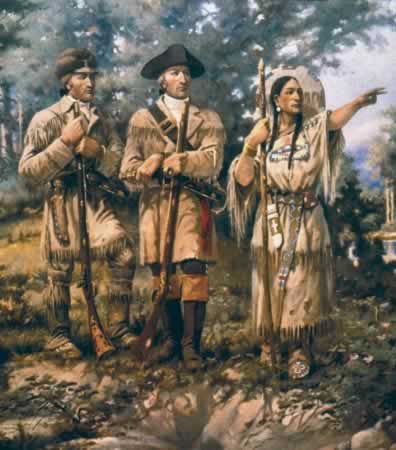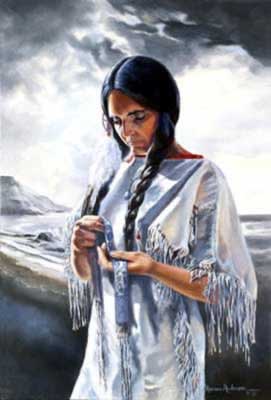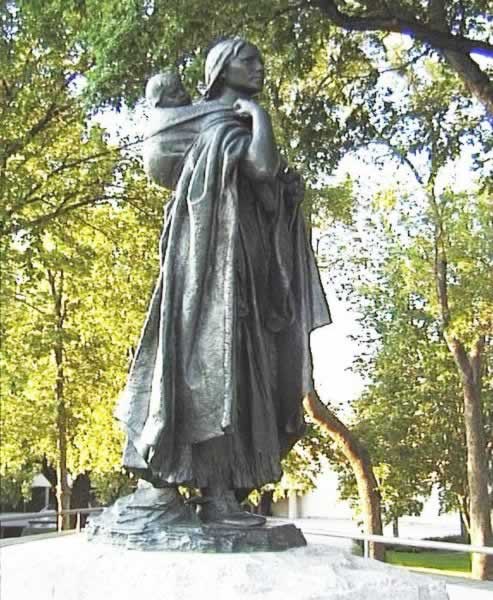Think that you may own a portrait or painting of Sacagawea? We identify, appraise and issue Certificates of Authenticity (COA) for all portraits of Sacagawea.

Portrait of Sacagawea and Child
Sacagawea was a Shoshone woman who accompanied the Corps of Discovery with Meriwether Lewis and William Clark in their exploration of the Western United States, traveling thousands of miles from North Dakota to the Pacific Ocean between 1804 and 1806. She was nicknamed Janey by some members of the expedition.

Lewis, Clark and Sacagawea at Three Forks, 1912 by Edgar Samuel Paxson
It is unlikely that many portraits were painted of the notorious American heroine during her lifetime. There are, however, many likenesses of her created based on written physical descriptions. Her image is emblazoned on the American gold $1 coin, and she is a popular figure for Native American history painters.

Sacagawea by Marian Anderson
Sacagawea was born to the Agaidika ("Salmon Eater") tribe of Shoshone between Kenney Creek and Agency Creek, near what is now the city of Tendoy in Lemhi County, Idaho. However, when she was about twelve years old, she and several other girls were kidnapped by a group of Hidatsa in a battle that resulted in the death of four Shoshone men, four women and several boys. She was then taken to their village near the present-day Washburn, North Dakota. She therefore grew up culturally affiliated with this tribe.
At the age of about thirteen, Sacagawea was taken as a wife by Toussaint Charbonneau, a French trapper living in the Hidatsa village, who had also taken another young Shoshone named Otter Woman as a wife. Charbonneau is said to have either purchased both wives from the Hidatsa, or to have won Sacagawea while gambling.
Sacagawea was pregnant with her first child when the Corps of Discovery arrived near the Hidatsa villages to spend the winter of 1804-1805. Captains Meriwether Lewis and William Clark built Fort Mandan and interviewed several trappers who might be able to translate or guide the expedition further up the river in the springtime. They agreed to hire Charbonneau as an interpreter when they discovered his wife spoke the Shoshone language, as they knew they would need the help of the Shoshone tribes at the headwaters of the Missouri River.
Charbonneau and Sacagawea spent three years among the Hidatsa after the expedition, before accepting William Clark's invitation to settle in St. Louis, Missouri in 1809. They entrusted Jean-Baptiste's education to Clark, who enrolled the young man in the Saint Louis Academy boarding school.
Sacagawea gave birth to a daughter, Squanto Lisette or Lizette, sometime after 1810. According to Bonnie "Spirit Wind-Walker" Butterfield, historical documents suggest Sacagawea died in 1812:
A few months later, fifteen men were killed in an Indian attack on Fort Manuel Lisa, located at the mouth of the Bighorn River. John Luttig and Sacagawea's young daughter were among the survivors. Some say Toussaint Charbonneau was killed at this time; others say he signed over formal custody of his son to Clark in 1813.
Reliable historical information about Sacagawea is extremely limited and no contemporary portraits of her exist. Her role in the expedition and this lack of records have led to a number of myths surrounding her.
Some Native American oral traditions are said to relate that rather than dying in 1812, Sacagawea left her husband Charbonneau and fell in with one of the Great Plains tribes while making her way back towards her homeland. She is said to have married into their tribe, then left again after her husband was killed, eventually finding her way back to the Lemhi Shoshone in Wyoming.
A Shoshone woman named Porivo ("chief woman") died at the Wind River Indian Reservation in Wyoming on April 9, 1884. A Reverend John Roberts officiated at her funeral, and claimed after her death that she had been Sacagawea.
In 1925, Dr. Charles Eastman, a Dakota Sioux physician, was hired by the Bureau of Indian Affairs to locate Sacagawea's remains. Eastman visited many different Native American tribes to interview individuals that might have known or heard of Sacagawea, although not her childhood clan the Agaidika Shoshone, who were confined at Fort Hall Indian Reservation and not at Wind River where the woman named Porivo died. It was his conclusion that Porivo was Sacagawea. In 1963 a monument to "Sacajawea of the Shoshonis" was erected on a Shoshone reservation near Lander, Wyoming on the basis of this claim.
The belief that Sacagawea lived to old age was widely disseminated in the United States by the novelist Grace Hebard who wrote a 1933 novel called Sacagawea. This notion was also explored fifty years later in the 1984 novel Sacajawea by Anna Lee Waldo; in this case the author was well aware of the historical research supporting an 1812 death, but made a conscious choice to explore the myths instead.
Some fictionalizations of the expedition speculate that Sacagawea was romantically involved with Lewis or Clark during their expedition. While the journals show that she was friendly with Clark and would often do favors for him, the idea of a liaison is believed to have been created by novelists who wrote about the expedition much later. This fiction was perpetuated in the 1955 Western film The Far Horizons.
Sacagawea is most famously remembered today in the form of statues in state parks and other public places:

Statue of Sacagawea in Bismark, ND
- Cheney, Washington, by Harold Balazs: A statue of Sacagawea is displayed in the rose garden in front of the President's House at Eastern Washington University.
- Bismarck, North Dakota, by Leonard Crunelle: A statue of Sacagawea and baby Pomp appears on the grounds of the North Dakota State Capitol, and a replica of it represents North Dakota in the National Statuary Hall in the United States Capitol. Interestingly, a North Dakota law, on the books for over a century, prohibits any statuary whatsoever on State-owned grounds, so a special law had to be passed in order to permit the display on the Capitol grounds, where it occupies a place of prestige on the lawn in front of the capitol building.
- St Louis, Missouri, by Harry Weber sculptor: A statue of Sacagawea with her baby in a cradle board is included in the diorama of the Lewis & Clark expedition that is on display in the lobby of the St. Louis Drury Plaza Hotel, located in the historical International Fur Exchange building.
- Portland, Oregon, by Alice Cooper: A statue of Sacagawea and Jean-Baptiste was unveiled July 6, 1905 and moved to Washington Park, April 6, 1906
- Godfrey, Illinois, by Glenna Goodacre: At Lewis and Clark Community College; by the same artist who designed the image on the Sacagawea dollar.
- Charlottesville, Virginia, by Charles Keck: A statue of Meriwether Lewis, William Clark and Sacagawea was sculpted in 1919.
- Boise, Idaho: Installed in front of the Idaho History Museum in July 2003.
- Great Falls, Montana, by Robert Scriver: Bronze 3/4 scale statue of Sacagawea, her baby Jean-Baptise, Lewis, Clark, and the Newfoundland dog Seaman, at the Lewis and Clark National Historic Trail Interpretive Center in Great Falls, Montana.
- Fort Benton, Montana, by Robert Scriver: A sculpture of Sacagawea and her baby, and Captains Lewis and Clark, in the river side sculpture park.
- Astoria, Oregon, at Netul Landing in Lewis and Clark National Historical Park: Bronze statue of Sacagawea and Jean-Baptiste.
While images of Sacagawea created during her lifetime are seemingly non-existent, it is very possible that they will some day surface. There is no telling whether she crossed paths with other early American explorers/artists who may have sketched her likeness in their journals…only time will tell.
Still wondering about a Native American painting in your family collection? Contact us... it could be a painting of Sacagawea.
